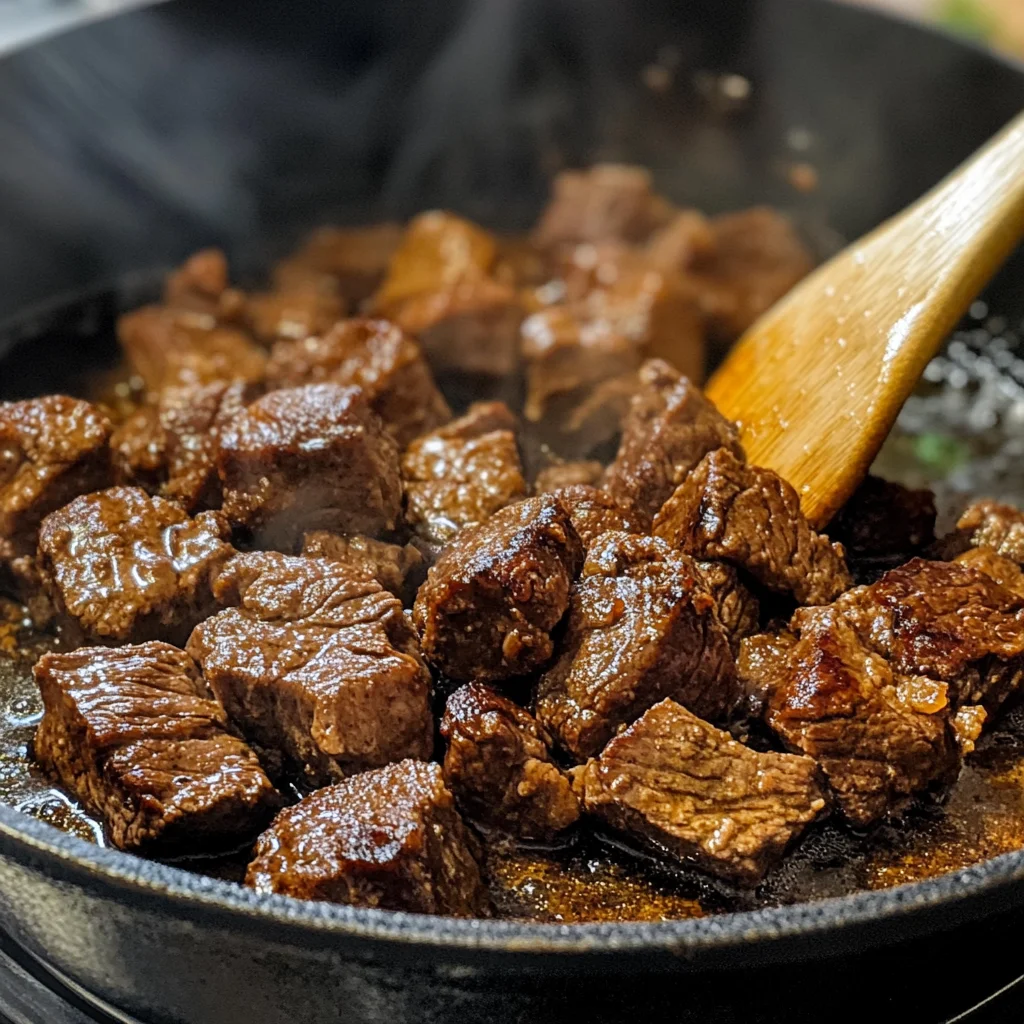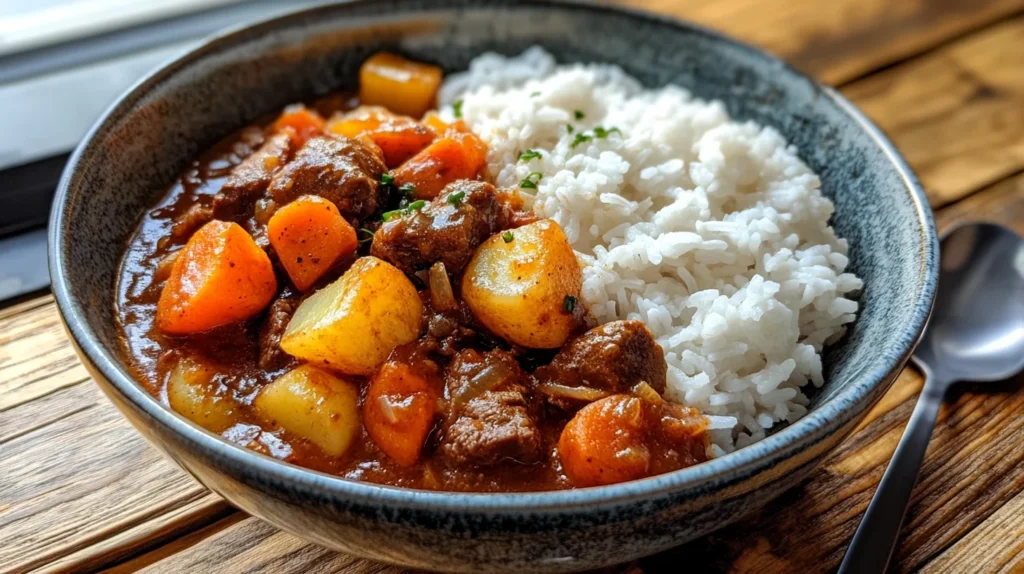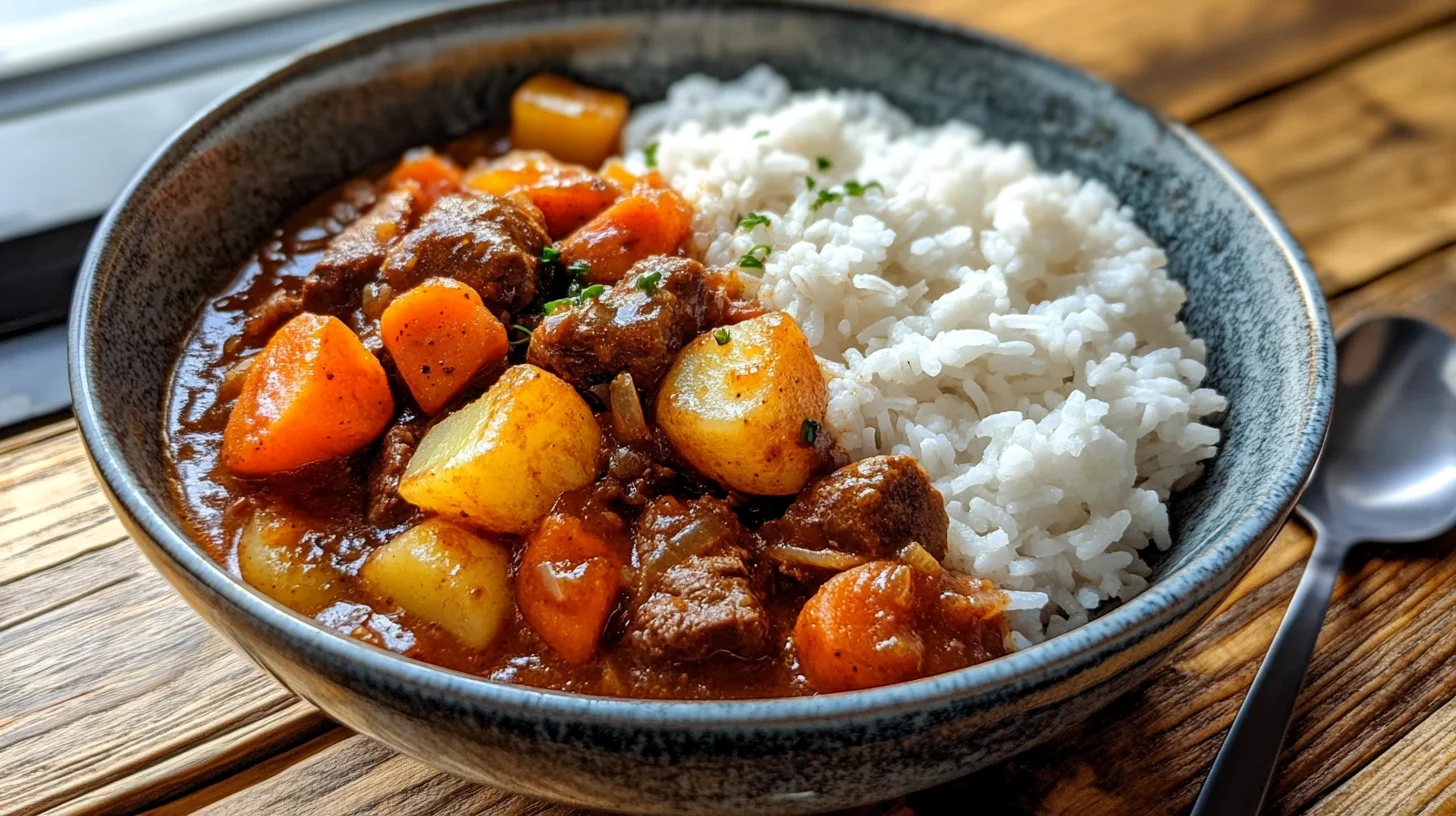Introduction to Hawaiian Beef Stew
If you’ve never tried Hawaiian beef stew, you’re in for a warm, hearty bowl of island comfort. This dish blends tender beef chunks, tomatoes, and vegetables into a rich, savory stew that’s deeply satisfying. Hawaiian beef stew is a staple in local homes and plate lunch spots across the islands. It’s cozy, simple, and packed with flavor — just like grandma used to make.
The best part? Hawaiian beef stew brings together familiar ingredients in a way that’s totally unique. The base is tomatoey, but not too thick. The beef is slow-simmered until it practically melts in your mouth. And the veggies soak up all the goodness. Whether you’re craving a taste of home or just something new and soul-soothing, Hawaiian beef stew hits the spot.
Ingredients for Hawaiian-Style Beef Stew
Here’s everything you’ll need to whip up a big pot of Hawaiian beef stew at home. These ingredients are easy to find and come together to create a deeply comforting, flavorful dish:
- 2 pounds beef stew meat (chuck roast or shoulder, cut into 1½-inch cubes)
- 1 tablespoon oil (vegetable or canola, for browning the beef)
- 1 medium onion, chopped
- 4 cloves garlic, minced
- 2 large carrots, peeled and sliced into thick rounds
- 3 medium potatoes, peeled and cut into chunks
- 1 15-ounce can tomato sauce
- 2 tablespoons tomato paste
- 2 cups beef broth (low-sodium if possible)
- 1 tablespoon soy sauce
- 1 tablespoon Worcestershire sauce
- 1 teaspoon sugar
- 1 teaspoon salt, or to taste
- ½ teaspoon ground black pepper
- 1 bay leaf
- Optional: ½ cup celery, chopped
- Optional: 1 cup frozen peas or green beans, added at the end for color and sweetness
These ingredients strike the perfect balance between savory and slightly sweet, which is a signature of Hawaiian-style comfort food. The soy sauce and sugar might seem like a surprise, but they’re the secret to that uniquely island-style flavor.
Essential Tools and Equipment
You don’t need anything fancy to make a killer Hawaiian beef stew, but having the right tools makes the process smoother and way less stressful. Here’s what you’ll want on hand before you start cooking:
- Large heavy-bottomed pot or Dutch oven – This is the heart of your stew setup. A Dutch oven holds heat well and gives you a nice even cook, which is perfect for slow-simmering stew beef until it’s fall-apart tender.
- Sharp chef’s knife – You’ll need a good knife for cutting beef into cubes and chopping all your veggies. A sharp blade keeps things safe and clean.
- Cutting board – One large board or two separate ones if you prefer to keep meat and veggies apart for food safety.
- Tongs or a wooden spoon – For turning the meat during browning and stirring the stew without scratching your pot.
- Measuring cups and spoons – To keep your ratios right. Even though stew can be a “taste-as-you-go” kind of meal, it helps to start with solid measurements.
- Can opener – For opening tomato sauce and paste. Trust me, it’s the little things that slow you down when you don’t have them ready!
- Ladle – Once the stew’s done, you’ll want a deep ladle to scoop up those big beefy, veggie-filled portions without making a mess.
- Optional: Slow cooker or Instant Pot – If you prefer a hands-off approach or want to prep it in the morning and come home to dinner done, both of these gadgets work great for Hawaiian beef stew too.
Getting everything prepped and laid out beforehand makes the cooking way easier. Plus, when you’re working with hot oil and simmering broth, being organized helps you stay safe.
Step-by-Step: How to Make Hawaiian Beef Stew
Step 1: Sear the Beef for Rich Flavor

Start by heating your oil in a large pot over medium-high heat. Once it’s hot, add the beef cubes in batches — don’t crowd the pot. Brown the meat on all sides to seal in flavor. You’re not trying to cook it through here, just get a good golden crust. This browning step adds depth to the stew’s overall flavor, so don’t skip it!
Once browned, transfer the beef to a plate and set it aside. You’ll build the stew base in the same pot, using all those tasty brown bits left behind.
Step 2: Build the Stew Base with Aromatics
Lower the heat slightly and toss the chopped onions into the same pot. Stir them around and let them get soft and golden, about 5–7 minutes. Add the minced garlic and cook for another minute, just until fragrant.
Next, stir in the tomato paste and cook it down for a couple minutes — this takes out the raw taste and makes the stew richer. Then pour in the tomato sauce, beef broth, soy sauce, Worcestershire sauce, sugar, salt, and pepper. Stir everything together well.
Drop the browned beef back into the pot along with any juices that collected on the plate. Toss in the bay leaf. Bring the whole pot to a gentle boil.
Step 3: Simmer Low and Slow
Once it starts bubbling, reduce the heat to low, cover the pot, and let it simmer for about 1.5 to 2 hours. Check it occasionally and give it a stir so nothing sticks to the bottom.
You’ll know it’s ready for the next step when the beef is fork-tender — meaning you can poke a chunk and it easily falls apart. That long simmer gives the beef time to soak up all the tomatoey goodness and get melt-in-your-mouth soft.
Step 4: Add Veggies and Final Seasoning
Add the carrots, potatoes, and optional celery to the stew. Stir everything in, cover the pot again, and cook for another 30 to 40 minutes, or until the veggies are tender.
Right at the end, taste your stew. Add a pinch more salt or pepper if it needs it. If you’re using frozen peas or green beans, stir them in now and let them cook for the last 5 minutes or so.
Once everything’s tender and flavorful, fish out the bay leaf and get ready to serve up a big, steamy bowl of Hawaiian comfort.
Tips and Tasty Variations for Hawaiian Stew
Hawaiian beef stew is a comfort food classic, but there are lots of fun ways to switch it up or make it your own. Here are some handy tips and tasty twists to try:
1. Use a mix of root veggies: While carrots and potatoes are standard, you can toss in sweet potatoes or even taro for a more island-inspired vibe. They add natural sweetness and creamy texture.
2. Add a splash of pineapple juice: Some home cooks add just a bit — about ¼ cup — of pineapple juice for a hint of tropical tang. It won’t make your stew taste fruity, but it gives a subtle balance to the tomato and beef.
3. Try it in a slow cooker: After browning the beef and sautéing the aromatics, you can transfer everything to a slow cooker and let it go on low for 6–8 hours. It’s a great way to let the flavors really develop without watching the stove all day.
4. Make it spicy: Hawaiian stew is usually mild, but if you like a little heat, toss in some red pepper flakes, a chopped chili pepper, or even a dash of hot sauce. It adds a nice kick!
5. Bulk it up with noodles or rice: Serve your stew over white rice — a classic in Hawaii — or mix in cooked macaroni near the end for a stew-meets-pasta dish. It’s hearty and filling either way.
6. Let it rest before serving: Like many stews, Hawaiian beef stew gets better after it sits for a bit. Let it rest for 10–15 minutes before serving, or make it a day ahead and reheat — the flavors deepen over time.
These small tweaks can totally change up your stew without straying too far from tradition. Play around with what you like best!
Common Mistakes to Avoid When Making Beef Stew
Even a simple stew can go sideways if you’re not careful. Here are some common slip-ups and how to dodge them:
1. Skipping the browning step: Don’t rush it! Browning the beef is key to adding layers of flavor. If you skip this step, your stew could taste flat or watery.
2. Crowding the pan: When browning meat, do it in batches. If you dump all the beef in at once, it’ll steam instead of sear. That golden crust makes all the difference.
3. Not cooking it long enough: Good stew beef takes time to break down. If it’s chewy or tough, it hasn’t simmered long enough. Be patient — low and slow wins the race.
4. Adding veggies too early: Potatoes and carrots don’t need as much time as beef. If you add them at the beginning, they’ll get mushy and fall apart. Toss them in during the last 30–40 minutes.
5. Overseasoning at the start: It’s tempting to salt everything up front, but as the liquid reduces, the flavors get stronger. Start light and adjust at the end when everything’s cooked.
6. Forgetting to taste as you go: Always give your stew a taste test before serving. A little salt, sugar, or acidity can bring the whole dish to life — but only if you check it.
Avoiding these pitfalls helps you make a stew that’s rich, hearty, and full of balanced flavor — just like it should be.
For a lighter, crunchy side, consider making these high-protein cottage cheese chips to snack on before or after your stew.
Nutritional Benefits of Hawaiian Beef Stew
Hawaiian beef stew isn’t just a comfort food — it can also pack some solid nutritional perks, especially when made with fresh, whole ingredients. While it’s definitely hearty, it can still be part of a balanced meal when you’re mindful of portions and ingredients.
First up, the beef. Stew meat is typically made from tougher cuts like chuck roast, which are rich in protein and essential nutrients like iron, zinc, and B vitamins. These nutrients help with everything from muscle building to energy levels. Plus, since the beef is simmered slowly, it becomes super tender without needing to fry or heavily process it.
The veggies play a big role too. Carrots bring in a good dose of beta-carotene, which supports eye health and immunity. Potatoes provide complex carbs and potassium, and if you throw in celery, peas, or even green beans, you’re adding fiber and a mix of vitamins to round things out.
One sneaky benefit of Hawaiian beef stew is that it can be lighter than cream-based stews. The tomato base adds flavor and richness without a ton of fat. Tomatoes are also high in lycopene — an antioxidant that may support heart health.
You can make it even healthier with a few swaps:
Use low-sodium broth to keep the salt in check, trim extra fat from the beef before cooking, and avoid overloading it with starchy sides. If you’re watching your carbs, consider using fewer potatoes or swapping in cauliflower chunks instead.
Bottom line? Hawaiian beef stew is a one-pot meal that brings together protein, fiber, and vitamins in a warm, satisfying way. It’s proof that comfort food and nutrition don’t have to be total opposites.
Leftover stew can even be served alongside savory waffles for a bold twist — try this waffle recipe with no milk for an easy base.
What to Serve with Hawaiian Beef Stew
Hawaiian beef stew is bold and filling all on its own, but serving it with the right sides takes it from good to unforgettable. In Hawaii, the go-to pairing is super simple: white rice. The soft, fluffy rice soaks up all that flavorful tomato broth, making every bite better. You’ll usually find a scoop or two right alongside a ladle of stew in a plate lunch.
If you want to branch out, here are some tasty ideas:
1. Macaroni salad: A staple in Hawaiian plate lunches, the creamy, slightly tangy flavor of mac salad pairs perfectly with the savory stew. It also cools things down if you added a spicy twist.
2. Sweet rolls or Hawaiian bread: A slice of sweet, soft bread is great for dipping and sopping up any leftover broth in the bowl.
3. Pickled veggies or kimchi: Adding something with a little crunch and acidity helps cut through the richness of the stew and keeps your palate interested.
4. Green salad with a citrusy dressing: A light salad balances out the heavier main dish. Look for dressings with lemon, lime, or pineapple juice to stay in the island spirit.
5. Brown rice or quinoa: Want a more wholesome option? Brown rice or quinoa still catches all that saucy flavor, but with extra fiber and nutrients.
6. Fried plantains or baked sweet potatoes: If you’re feeling creative, these add a sweet-savory twist that works surprisingly well with the tomato base of the stew.
No matter what you serve it with, Hawaiian beef stew brings comfort and warmth to the table. The real secret? It tastes even better when shared with friends and family.
If you’re looking for a sweet treat to end the meal, this banana bread with no butter is a soft, simple option that pairs great with stew.
Frequently Asked Questions
What is Hawaiian stew at Zippy’s?
Zippy’s is a beloved restaurant chain in Hawaii known for its comforting local dishes, and their Hawaiian beef stew is a top favorite. It’s a tomato-based beef stew made with tender chunks of meat, carrots, and potatoes, all simmered until rich and flavorful. What sets it apart is its slightly sweet, savory balance — a signature of many Hawaiian-style recipes. The Zippy’s version is super homey and often served over rice, making it a true island classic.
What is the secret ingredient in beef stew?
In Hawaiian beef stew, it’s all about balance — and the secret ingredient that brings it together is usually a touch of sugar or soy sauce. That little bit of sweetness mixed with savory tomato and tender beef creates a deep, well-rounded flavor. Some cooks also swear by Worcestershire sauce or even a splash of pineapple juice to give it a subtle depth that’s hard to pinpoint but so satisfying.
What enhances the flavor of beef stew?
Flavor in beef stew builds over time, but a few tips help it shine. First, browning the meat well at the start makes a huge difference — it locks in flavor and creates a rich base. Second, cooking it low and slow allows all the ingredients to blend and the beef to get tender. Finally, a good splash of umami boosters like soy sauce, tomato paste, or Worcestershire sauce takes it up a notch. Don’t forget to season at the end — sometimes just a little salt or acidity can make everything pop.
How to cook stew beef so it’s tender?
The key to tender stew beef is time and temperature. You want to cook it low and slow — either on the stovetop, in a slow cooker, or even in an oven-safe pot at low heat. Simmering for at least 1.5 to 2 hours gives the connective tissues in the meat time to break down, turning tough chunks into melt-in-your-mouth bites. Always make sure there’s enough liquid in the pot, and keep the temperature gentle — boiling too hard can make beef tough instead of tender.
Can I make Hawaiian beef stew ahead of time?
Absolutely! In fact, it tastes even better the next day. Let it cool, store it in an airtight container, and reheat it gently on the stove or in the microwave. The flavors deepen overnight, making leftovers something to look forward to.
Is Hawaiian beef stew spicy?
Traditionally, no — Hawaiian beef stew is mild and kid-friendly. But you can add heat if you like! A pinch of red pepper flakes, some hot sauce, or chopped chili peppers will spice things up without changing the overall vibe of the dish.
What’s the best beef to use for Hawaiian stew?
Chuck roast or shoulder cuts are ideal. They’re tough at first, but full of flavor and perfect for long, slow cooking. When simmered properly, they become super tender and juicy — exactly what you want in a stew.
Can I freeze Hawaiian beef stew?
Yep, it freezes well! Just let it cool completely, portion it into freezer-safe containers, and label it. It’ll keep for up to three months. When you’re ready to eat, thaw it overnight in the fridge and reheat it slowly so the texture stays nice.
Wrapping Up: Why You’ll Love This Hawaiian Classic
Hawaiian beef stew isn’t just a meal — it’s comfort in a bowl. Whether you grew up with it or you’re trying it for the first time, it brings together rich flavors, tender beef, and down-home goodness that’s hard to beat. What makes it special is its simplicity — nothing fancy, just wholesome ingredients cooked with love and patience.
From busy weeknights to lazy Sundays, this dish fits the bill. It’s easy to make, easy to customize, and just plain satisfying. Serve it with rice, enjoy it with family, and don’t be surprised if it becomes one of your go-to comfort meals.



1 thought on “Hawaiian Beef Stew: A Comforting Island Favorite with Tender Meat and Veggies”